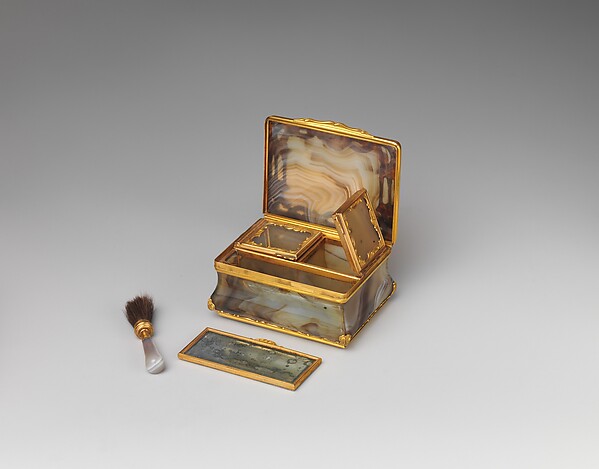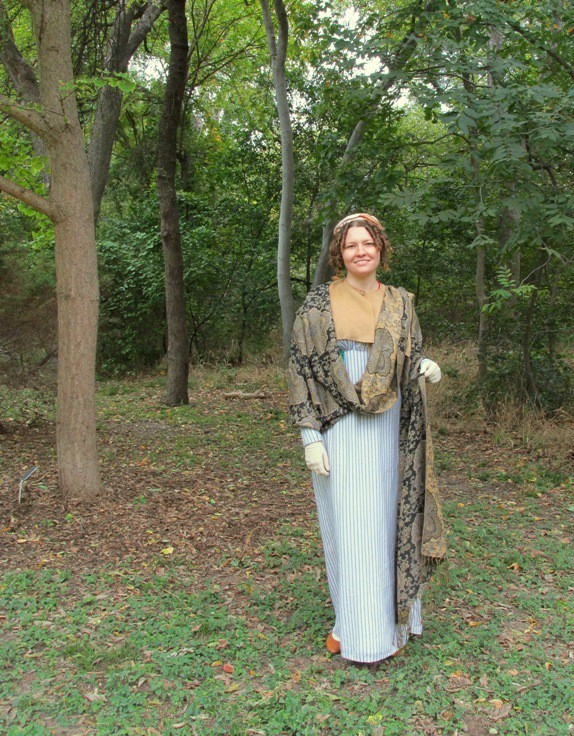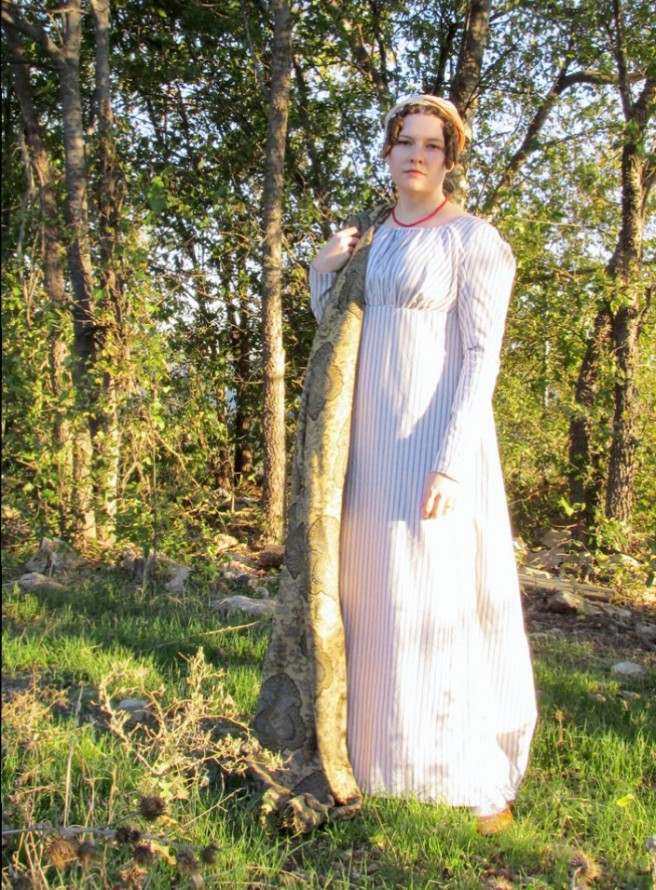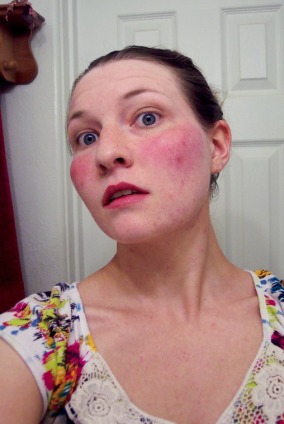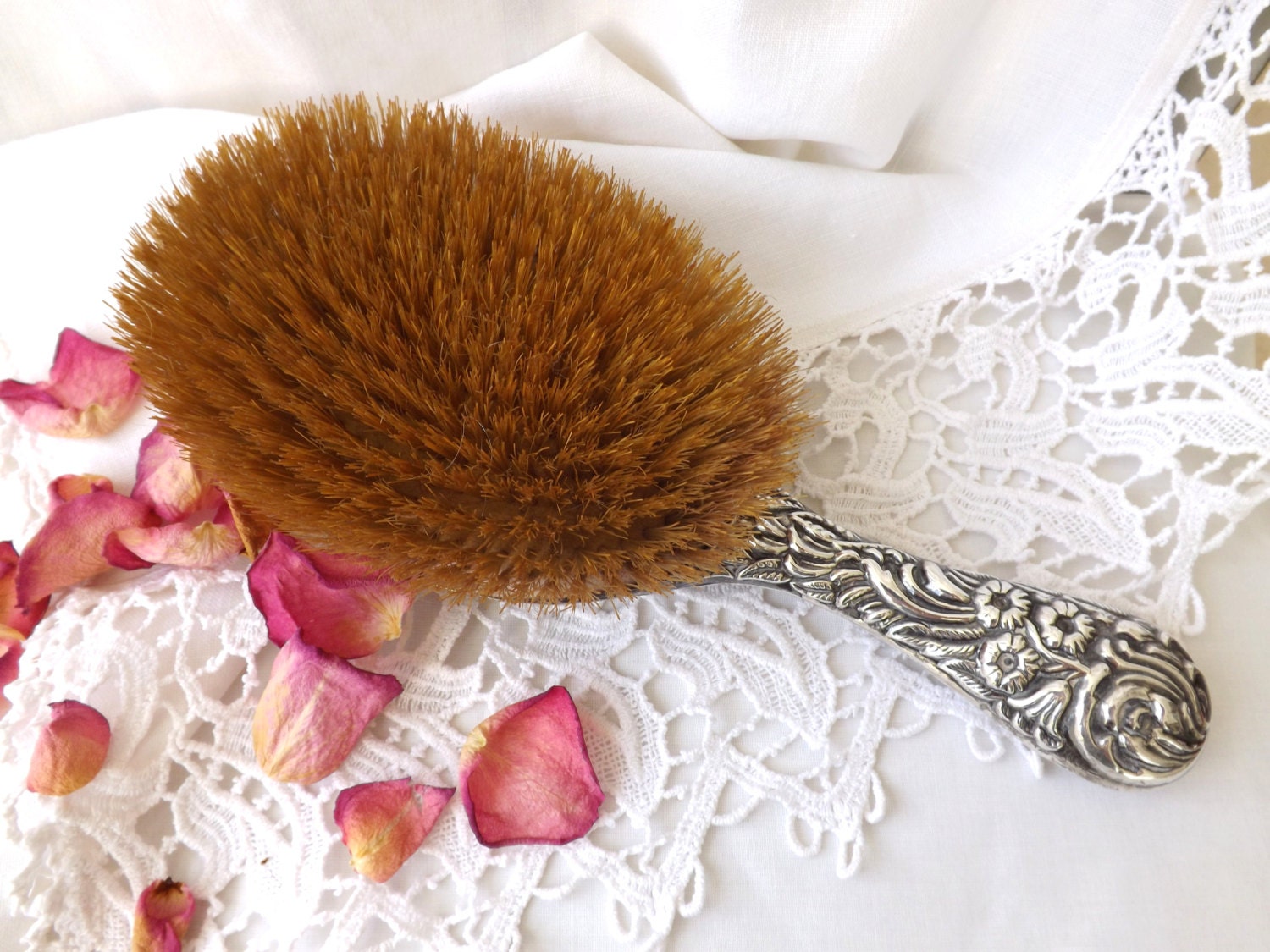When the Rose Blooming in Your Cheeks Happens to be White
I had a lovely time at Georgian Picnic despite the frigid weather. In my rush to get all my warm layers on, however, I completely neglected to apply any makeup!
Do I have something on my face? NO?! Dang it!
Normally I wouldn’t be bothered by this. I enjoy playing with makeup, but I rarely wear much of it. In fact, my bare face would be considered properly accurate for a period portrayal. Many reenacting circles encourage their female participants to forgo makeup and a common critique of a farb/newbie is their overt use of modern makeup (mascara, for example, wasn’t invented until the 1910s and wouldn’t be worn by a pre-1920s woman). That said, it’s important to note that a naked face may be a “safe” option, but it is not always necessary or even appropriate.
Cosmetics Box for Rouge and Patches, circa 1750-55
Our ancestors adored cosmetics just as much as we do. While they couldn’t walk into their local drugstore and choose from two hundred shades of eyeshadow and lipstick, women did have access to cosmetics both homemade and store bought. Upper class women famously indulged in cosmetics during all eras, even during the relatively conservative Victorian era. The wide range of anti-makeup rants may seem like evidence to the contrary, but there must have been enough women breaking the “rule” to inspire that many complaints!
Indeed, depending on the era, it may be less accurate to go bare faced. The ancient Egyptians and 18th century Georgians are especially well known for their love of makeup. A noblewoman (or nobleman) in these eras would have indulged heavily in various makeups as a part of their regular routine, even more so for court appearances.

The Six Stages of Mending a Face by Thomas Rowlandson, May 29th, 1792
The image above links to an alternate version in the Met. It was quite a popular print and there are a few different variations around the web. Poor Lady Archer! 200 years later and everyone is still laughing at her morning…face.
Commoners were not exempt from cosmetics entirely; though compared to their wealthy contemporaries, their options were much more limited. Homemade rouges, powders, and creams were all popular. The Industrial Revolution played a huge role in making cosmetics more widely available. With so much emphasis placed on a woman to be not only accomplished, but also beautiful, many enterprising entrepreneurs stepped in to provide the beauty nature may have not been generous enough to give. By the Victorian era, even a servant girl might afford a small jar of skin brightening cream, though she might have been better off skipping it thanks to some being laced with toxins!
They must be safe! Everyone knows that printed words never lie…
Many modern women avoid makeup for just that reason– well, maybe not for poison, but certainly for allergic reactions, environmental concerns, or a desire to keep certain chemical substances out of their bodies. In addition, makeup then and now is often tied to morality and societal roles.
Throughout the ages, most arguments for or against makeup are strongly tied to women’s freedom of expression and sexuality. As those values fluctuate, so does the stance on makeup. In Victorian England, for example, makeup was seen as morally corrupt since it “lied” about a woman’s appearance and was associated with prostitution.
In this photo, Belle Archer (not related to the Lady Archer previously caricatured) is wearing stage makeup and looking rather sad for a series of modelling photos taken during her career as an actress. The heavy stage makeup paired with the comparatively skimpy stage outfits 19th century actresses wore made them a target of public ridicule just as many modern starlets are mocked in the tabloids. Time has softened past judgements, however, and Belle is known as one of the Victorian era’s greatest beauties.
Makeup still carries many of those negative connotation today, but with the added bonus of being a required part of daily life. We can thank early 20th century marketers for that. They created a whole new persona for makeup and other hygiene products. Makeup became the symbol of a well-groomed, proper lady. To leave the house without completely covering the face was considered slothful and makeup was as indispensable to an outfit as shoes. To compromise these two views, today’s woman is encouraged to “go natural,” i.e. wear makeup, but not in a noticeable way. We walk a fine line! The prevalence of digital media in modern life makes it all the more challenging. We live our lives through the ever-gazing electronic eye of a camera lens.
So, how does all this tie back to Georgian Picnic? Well, I am not a strict historical reenactor. I costume for personal pleasure and enjoy socializing with others who share my passion. We agonize over every detail, from the colors to the textures to the smallest button on a cuff. We invest a lot of time and money in our work, so we want to make darn sure everything is the best it can be!
The costume doesn’t stop at the dress. Any costumer will tell you that the right undergarments, hair, and accessories are what make or break an outfit. Faces, however, are rarely emphasized. I think it stems from the modern ideal of personal freedom and beauty. No one likes to be told how they should look, especially if it’s genetically out of our control. I am no exception. I am stubborn, insecure, and probably more than a little vain. Vanity has heavily implied negative connotations, but striving to look your best is natural and, in the case of costuming, kind of the point. We want beautiful clothes that in turn make us feel beautiful so we can take beautiful pictures in beautiful places to make all-around beautiful memories!
There is no memory more beautiful than six Regency Wedgies (and some 18th century ones) all in a row…
The glory of modern HD photography is also a bit of a curse. Humans react emotionally to contrast and color. A lot of human beauty stems from increased contrast, which is why humans in many different cultures have embraced lining the eyes with dark colors. Rouge on the lips also serves the same purpose. By increasing the color and contrast, the features and expressions of the face become easily discernible. It also helps them show up better at distances (which is why stage makeup is so heavy) and in photographs. If you are pale skinned with pale eyes and pale eyebrows like me, your features will all blend together on camera, which is what happened in many photos from Georgian picnic:
Little did Jen know that in this shot, I had replaced myself with a wax figure!
So, a bare face is historically accurate, but not so flattering in modern photos! Part of it was the weather. Had it been warmer and sunny, I would have had a bit more natural flush, especially in my lips, but the cold sucked all the color right out of my cheeks, making me look waxy and exhausted. Perhaps it’s just my insecure vanity talking, but I find my sickly complexion distracts from my outfit. Now I know why all those antique beauty and women’s housekeeping books emphasize complexion so much!
However, unlike 19th century ladies, I rather like my freckles. My sun damage is adorable!
So, if you are going to an event and are hoping to get some flattering photos, adding a little bit of modern makeup to your face might be helpful. I don’t know if I’d call the following a tutorial, per se, but it’s what works for me…when I remember to do it, of course!
Depending on your natural facial contrast, a bare face might be just fine, but if you would feel more comfortable with a little natural-looking enhancement, take cues from our ancestors! I prefer to stick to a natural look. I find leaving the majority of my skin alone (no foundation or powders) greatly helps with this. However, my pale lips and skin do benefit from some pre-packaged “youthful glow.” Women throughout history have used rouge to this end. You can buy modern rouge in liquid and powder form, but it’s very simple to use a modern lipstick as both a blush and lip color. Just dab it on lightly rather than swiping.
I like a neutral shade that’s fairly close to my natural color. “Kasbah” by Rimmel London, if you were curious.
Sometimes I prefer to use lipstain rather than lipstick much of the time because it applies matte, sinks into the lips, and sticks around for longer than a lipstick (it doesn’t work very well as a blush, though). For a Renaissance or 18th century look, red lipstick dabbed on with your finger is great for mimicking the look of rouge from those eras. I also carry a tinted lip balm with me to events now, especially outdoor ones. Texas gets hot and dry, so protecting your lips with a balm with SPF and a little hint of color is smart. Just swipe it on for protection and a touch of color!
Next, it’s time to go a little anachronistic: Mascara! Remember, I’m not aiming for historical accuracy. The goal is to boost confidence and take photos everyone can be proud of. Indeed, that glorious goop I just declared unfit for pre-1920 wear is a godsend if you are planning on taking photos! It helps increase the contrast of your eyes, making them look brighter. Our ancestors valued long, dark lashes just as much as we do, but while they had to be born with them, we are blessed to be able to apply them right out of a tube. In lots of old paintings, you’ll notice that artists put a line of black or dark brown over the top of the eye to set the eye off.
An early 19th century lover’s eye pendant.
I need to make myself one of these!
You might assume, then, that eyeliner would be appropriate, and it might be, depending on what era/culture you are portraying. However, eyeliner is jarringly unnatural on the face and the dark line in paintings is really there to indicate the presence of lashes. A very light coating of mascara, therefore, is the perfect solution and blends much more naturally with the face.
I have deep set eyes, so eyeliner would disappear into the crease anyway.
Blonds, redheads, and light brunettes should choose a brown or brown-black for a natural look. Darker brunettes and folks with black hair can use true black. It’s easy to overdo it, so use a light touch. A single, swift coat on the upper lashes only is all you need! I often blot the wand off on a cloth or tissue before applying so I avoid a heavy coating.
This might be enough for most ladies. However, I have one extra step in my routine: eyebrows. You never know how important eyebrows are until they’re gone!

Yup. That’s Anne Hathaway without eyebrows.
Turns out “celebrities without brows” is an internet meme of sorts. It’s kind of unsettling how different folks look without them!
While my brows are just dark enough to be visible and an okay shape for my face, they do disappear in far shots.
Through an odd quirk of fate, my eyebrows are perfect for the Elizabethan era. Queen Liz and I share a name and eyebrows/lack thereof. Going eyebrow-less was trendy during her reign.

Pale, sassy, and proud!
However, the Regency period and the century before and after it valued darker brows. Turns out getting nice, fashionably full eyebrows was a challenge for ladies in the past, too. They had a whole list of remedies for sparse brows, including burnt cloves and mouse skin strips! Instead of massacring the local rodent population, I use either eyeshadow in a color that matches my hair or a bit of brown mascara depending on my mood. I avoid using an eyebrow pencil because, like eyeliner, the outline it creates looks too crisp and modern. The ideal Georgian, Victorian, and Edwardian brow was arc-shaped instead of angular. They stretched like a gentle rainbow over the eye and were often full across the entirety of the brow rather than just by the nose. My face can’t handle that kind of brow, so I just fill in my natural shape.
It also brings out that fetching, perpetual “Huh?” look on my face.
The fact that you’re wearing makeup might be noticeable in person, but if you’ve done everything delicately enough, it will harmonize with your outfit, pulling the look together in a way that will satisfy both your costuming sensibilities and your modern tastes without being distracting. Win-win!
When lighting and weather fail to flatter, makeup can really help you save face. Now, even at a distance in terrible lighting, everyone can see your Regency bitchy resting face perfectly!
I thought I was smiling when I took this photo. Turns out, I was mistaken.
Makeup cannot, however, protect you from sudden gusts of wind.
If you are interested in wholesome historical cosmetic options (I strongly recommend skipping the lead white!), there are many recipes available online to recreate antique cosmetics using natural ingredients. Madame Isis’ Toilette, for example, details 17th and 18th century recipes, mixes them, and shows you the results. Various vendors online like Little Bits also sell recreations of perfumes, rouges, and powders. In my own experiments, I’ve dabbled with beet juice rouge and had pretty entertaining results!
Lady Archer would be proud.
Ultimately, the type of makeup and the amount you wear depends on the era and class you are costuming for, the type of event you are attending (reenactment, afternoon tea, convention, etc.), and your personal taste. Makeup for conventions, for example, is often heavier and theatrical in nature both to show up on camera better and portray a specific character. Plus, some of us just like to wear more makeup than others. Just find what works best for your situation and roll with it!


